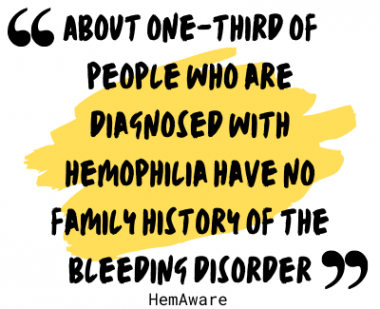Those With Bleeding Disorders Should Beware of the Tonsils

A simple tonsillectomy led to my eventual diagnosis of hemophilia B and von Willebrand disease. Without a family history, a bleeding disorder wasn’t on my family’s or pediatrician’s radar. I had to almost bleed to death for a bleeding disorder to be suspected.
Terror of the tonsils
The year was 1975. I was 10 years old. “Something is wrong,” my dad said.
Seven days earlier, I’d had my tonsils removed. In 1975, that involved a few nights in the hospital. After surgery, I vomited blood in the hospital bathroom, enough that my mom pulled the emergency cord summoning the nursing staff.
Now I was at home, lying in bed with blood oozing out of my mouth. Then I started vomiting blood again.
My dad called the surgeon, who instructed us to head to the ER. He said the nurses would call him if the bleeding didn’t stop, but not to worry. It would probably stop on its own.
My parents and I went off in our Suburban to Ascension SE Wisconsin Hospital-Elmbrook Campus in Brookfield, Wisconsin. The nurse stuck a tongue depressor down my throat to have a look. The tongue depressor emerged from my mouth covered with blood, so she left the room to call the doctor. The nurse instructed me to lie down and try to sleep. (Yeah, right.)
My surgeon arrived, and a procedure was done to cauterize and restitch my throat. The surgeon used a kitchen tonglike device to shove cotton balls infused with cocaine down my throat to numb the area. I tried my hardest not to swallow. At age 10, I met the kindest nurse in the entire world. She held my hand and taught me about the perils of cocaine. I am grateful to her to this day.
The pediatrician suspects a problem
My pediatrician started putting the pieces together and suggested I visit a hematologist specializing in bleeding disorders at the children’s hospital in Milwaukee. My pediatrician made a remarkable catch. Girls weren’t supposed to be bleeders.
The children’s hospital was a dark and depressing place in those days. I was led to a dank basement for “bleeding time” tests and blood draws on multiple visits. I still bear scars from bleeding time tests, a barbaric way to tell how long it takes your blood to clot. A razor blade cuts your skin. The technician blots away the blood while holding a stopwatch to time when the bleeding stops.
After many tests, I was diagnosed with several bleeding disorders. My parents were shocked and confused.
According to HemAware, the magazine produced by the National Hemophilia Foundation, “About one-third of people who are diagnosed with hemophilia have no family history of the bleeding disorder.” My hematologist later explained that this happens when a genetic mutation occurs and introduces hemophilia into a family.

(Graphic by Jennifer Lynne)
We had no idea what to expect. I remember my mom explaining, “Your deep blood doesn’t clot the way it should.” Huh? Nobody explained how a bleeding disorder would affect me once “Aunt Flo” started to visit. At the time, Google and Facebook didn’t exist for research and support.
Bloody noses, heavy menstrual bleeding, iron deficiency, and surgical complications related to bleeding are all bleeding disorder symptoms. Women with these problems deserve to be tested and offered treatment before a life-threatening emergency arises. If you can relate, I implore you to discuss the possibility of a bleeding disorder with your doctor. And beware of those tonsils!
Note: Hemophilia News Today is strictly a news and information website about the disease. It does not provide medical advice, diagnosis, or treatment. This content is not intended to be a substitute for professional medical advice, diagnosis, or treatment. Always seek the advice of your physician or another qualified health provider with any questions you may have regarding a medical condition. Never disregard professional medical advice or delay in seeking it because of something you have read on this website. The opinions expressed in this column are not those of Hemophilia News Today or its parent company, Bionews, and are intended to spark discussion about issues pertaining to hemophilia.







Tiffany Elliott
Thank you for your article. I read of another, Bob Massie, who was diagnosed with hemophilia, despite having no family history of the condition. I was diagnosed with Asperger Syndrome/ASD at 27, despite similar circumstances - although my mother's eclampsia was the most likely cause. I was born at 26-28 weeks, in September 1984, via emergency c-section, after my mom had a seizure that they thought likely killed me. This is something I've been interested in most of my life and have incorporated into my own writing. Like you, I have a B.A. in journalism (Interdisciplinary Arts and Sciences, Communications, the University of Washington). If you feel comfortable, I would love to talk further. Thank you.
Jennifer Lynne
Thank you, Tiffany! When there isn't a family history of a bleeding disorder, diagnosis and treatment are more complicated, especially so when I grew up. We had no idea what to expect or what was happening.
L Macdonald
I had a similar experience with my tonsillectomy. Blood transfusions would only temporarily stop the bleeding. A doctor at the Ottawa Civic managed to stop the throat bleeding. My blade scar is on my ankle. Nose bleeds are frequent. A doctor at Toronto East General diagnosed me with mild hemophilia A several years later. Cyclocapron has been an excellent treatment.
Jennifer Lynne
Thank you for sharing! My blade scars are on my forearms - what a crazy test that was. I am glad you arrived at a diagnosis.